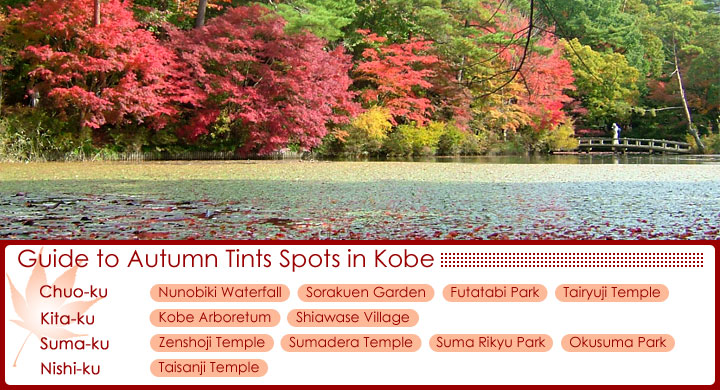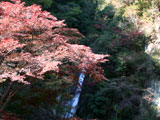
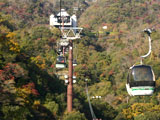
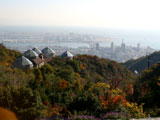
Nunobiki Waterfall is located about a 15-minute hike on the mountain path to Mt. Maya facing north from the Shin-Kobe Station of JR Shinkansen. This waterfall is called one of Three Large Divine Waterfalls in Japan along with Kegon-no-taki in Nikko and Nachi-no-taki in Wakayama. Nunobiki Waterfall is the collective name for four waterfalls: Odaki, Meotodaki, Tuzumigataki, and Medaki. The Odaki waterfall is 43m high. Water flowing downstream from the Nunobiki Reservoir, location of Japan's oldest concrete dam completed in 1900, flows over this waterfall into the Ikutagawa River. There is the Nunobiki observation platform, which is about a 10-minute hike up the trail from Nunobiki Waterfall. Facing Ikutagawa River from there, you can have an excellent view of Port Island and Osaka Bay.
The Nunobiki Waterfall is a beautiful waterfall that resembles a draped white cloth as its Japanese name suggests. The waterfall is a magnificent sight as it glistens in the backdrop of a white rock surface and the early foliage in spring or the colorful leaves in autumn. It has been celebrated from ancient times and was the choice of the aristocrats in Heian period as a place to compose poetry. In the vicinity of the waterfall there is a monument that reads "Nunobiki Waterfall's Thirty-six Laureates of Waka Poets." The Ministry of Environment also selected "Nunobiki Mountain Stream" as one of "Japan's Top 100 Remarkable Waters."
When you ride the ropeway leaving from west of Shin-Kobe Station, you can see the Nunobiki Waterfall below you as you arrive at the Nunobiki Herb Garden Station. At this station you can see the urban district of Kobe City and Osaka Bay, and in autumn there are nearly 200,000 sage flowers planted within the park. Visitors can enjoy seeing the vivid autumn leaves of the surrounding trees such as maple and Quercus serrata while breathing in the sweet fragrance of sage.

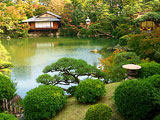
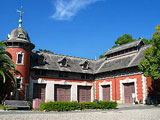
Sorakuen Garden" is the only traditional Japanese landscape garden among the city parks of Kobe City. It had been a private residence built at the end of Meiji by the father of former Kobe mayor Kenkichi Kodera and was donated to Kobe City in 1941. Because the magnificent mansion and annex within the park burned down in air raids during the World War II, only a western style stable (designated an important cultural asset), fence, and gates remain from the original building before the fire. However, in 1963 the Sorakuen Hall and teahouse were completed and Hassam House (designated an important cultural asset), formerly of the Kitano district of foreign settlements, was moved and rebuilt on-site. The tatami room taken from the river cruising barge of feudal lord Himeji was reconstructed in 1980, and is displayed giving visitors a glimpse of the past.
Large camphor laurel trees, forest of sago palm plants, and garden lanterns remain in the park and are preserved in a magnificent view. They are arranged beautifully within the park, and in autumn the maple trees and dogwood trees add color and soothe the spirit of the many visitors. The autumn leaves can also be enjoyed along with the beautiful chrysanthemums since the Kobe Chrysanthemum Exhibition is hosted every year from the end of October to the end of November.
| Access | Walk 5 minutes north from the Kencho-mae Station of the Kobe Subway. |
|---|---|
| Hours | 9:00 to 17:00 (Park entrance until 16:30) |
| Closed | Thursdays (or following day when falling on a national holiday), New Year Holidays (Dec.29 to Jan.3). However, open every day during the Kobe Chrysanthemum Exhibition (Oct.20 to Nov.23). |
| Entrance Fee | 300 yen for adults, 150 yen for elementary and junior high school students |
| TEL | 078-351-5155 |
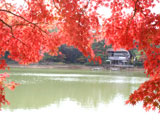
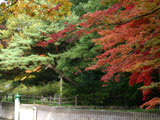
To access Futatabi Park, take the city bus #25 from JR Sannomiya Station for approximately 20 minutes and get off at the Futatabi Park bus stop located on the north side of Mt. Futatabi (470m elevation). Here in the middle of forest along the Mt. Futatabi Driveway is a park centered on the Shiogahara Pond and filled with nature. Along with the beauty of plum blossoms in early spring followed later by cherry blossoms and azaleas in late spring, the park is well known as a place for viewing beautiful autumn leaves and is a prominent tourist attraction even within the Kobe City. The entire park is considered important as a permanent botanical refuge and is protected. A restaurant, boat rental shop, and walk path are in the vicinity of the park and numerous hikers visit the park in each of the four seasons.
Around the Shiogahara Pond, particularly in the full force of autumn, vivid colors appear in the maple, Quercus serrata, and Rhus succedanea trees, and the area bustles with people on autumn excursions to see the red autumn tints of the changing leaves.
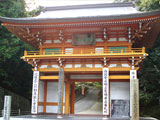
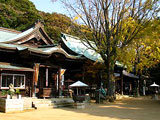
Tairyuji Temple stands at the foot of Mt. Futatabi and is surrounded with abundant nature for visitors to enjoy throughout each season such as cherry blossoms and azaleas in spring and red tinted leaves in autumn. To access Tairyuji Temple, take city bus #25 from JR Sannomiya for about 15 minutes, and you will arrive at the bus stop "Tairyuji." The scarlet temple gate can be seen in the woods along the scenic Mt. Futatabi Highway. Here Wake no Kiyomaro opened the temple of the Shingon Sect in 768. It is called the big dragon temple after Kiyomaro was rescued by the incarnation of the bodhisattva appearing as a giant serpent.
Around 1334 powerful families of the region repaired the temple and Tatabe Castle (Futatabi Castle) was made, but it was burned down during fighting. In the beginning of the Edo period, the buildings were restored as a temple. The wooden statue of the bodhisattva serving as the principal icon of the temple was carved around the middle of the 8th century, and in 1929 the statue was designated as a national important cultural asset. Every year on July 20th, it is publicly unveiled and has a miraculous effect for ensuring safe baby deliveries and prevention of paralysis.
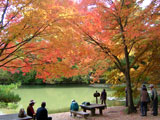
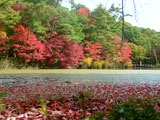
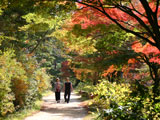
The Kobe Arboretum has approx. 1,200 types of trees and shrubs, including alpine plants, with the plant life arranged by place of origin. It is Japan's largest botanical garden (1,426,000 �u) where flowering plants and wild birds can be seen in each of the four seasons. The natural forest can be enjoyed throughout the year in the flowers and the verdure of early spring, the azalea and the rosebay of late spring, the hydrangea of the rainy season, red-tinted leaves of autumn, the winter groves.
In mid- to late-November the splendor of the autumn leaves is fully revealed in vivid colors in 38 tree varieties including maples, Quercus serratas, wax, larches�Adawn redwoods, and American sweetgums dispersed among the roughly 3,000 mountain trees originating from Japan and regions from around the world. There is an especially delightful brilliance emanating from the surroundings of Hase-ike Pond that provides a pleasurable experience through the beauty of the assorted autumn leaves such as maple, Acer pycnanthum, and Acer palmatum. "Walking among the Autumn Leaves of the Forest" is held every year from November 1st-30th, and activities such as walks among the autumn leaves and a koto concert can be enjoyed.
| Access | �ETake a shuttle bus leaving from "Kita-Suzurandai Station" of the Kobe Railway every hour. �ETake city bus #25 from Sannomiya and get off at "Kobe Arboretum (available April to November: Sat., Sun., and national holidays) |
|---|---|
| Hours | 9:00 to 17:00 (Park entrance until 16:30) |
| Closed | Wednesdays�ithe following day when falling on a holiday�jNew Year holidays�iDec.29-Jan.3�j |
| Entrance Fee | 300 yen for adults, 150 yen for elementary and junior high school students |
| TEL | 078-591-0253 |
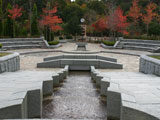
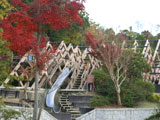
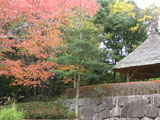
To access Shiawase Village, take the city bus #66 bound for Shiawase Village from JR Sannomiya for roughly 25 minutes. Here is a comprehensive relaxation area for public welfare supporting the independence and social involvement of the disabled and elderly people, beginning with every type of sports and recreational facility imaginable. The area is equipped with campsites, overnight lodging, jungle hot springs, and even a horseback-riding park. Not only do the disabled and elderly people come to Shiawase Village to spend a relaxing moment in natural beauty but also people of all ages from children to adults come here to enjoy such activities as camping, having a barbecue picnic, bathing in hot springs, or strolling in a beautiful Japanese garden. In particular, visitors can enjoy the harmonious setting of an authentic Japanese garden centered on a pond suitable for taking walks to appreciate the scenery where Japanese emotion overflows from the teahouse to the natural beauty of the four seasons.
In autumn with the changing of the leaves, striking colors can be seen inside the Village. There are cherry trees (at the Lawn Bowling Green), zelkova trees (near the north and south gates and at the exercise grounds), tulip trees (Central Green Path), American sweetgum trees (along the north side path of Aozora Activity Center and in the vicinity of "Silver College" bus stop), trident maple trees (near the camping sites), maple trees (in the Japanese garden), and Quercus serrata and Sawtooth Oak trees (near the mountains).
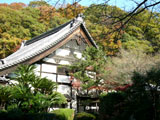
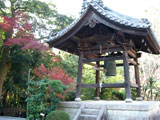
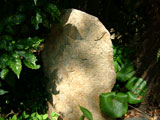
Zenshoji Temple is a temple with a lineage associated with the Nanzenji school of the Rinzai sect of Zen Buddhism founded by the priest Getsuan some 600 years ago. To access the temple, take the city bus from Itayado Station of the Sanyo Railway and get off at the Zenshoji Temple bus stop.
Within the grounds there are naturally many old maple trees as well as on the mountain behind the temple. The temple is also called by the nickname of "Momiji (autumn leaves) Temple" because of the particularly beautiful leaves around the main building in autumn when it bustles with throngs of visitors. Hirofumi Ito, the first governor of Hyogo Prefecture, also visited this temple and a stone monument remains with an inscription of the Chinese poem he wrote extolling the autumn leaves. The sight of the white, roofed mud-wall, the bushes of a bamboo thicket, and the temple gate built by a famous carpenter Hidari Jingoro recall the past.
Additionally, this temple is also well known around the country as an "inn" for sparrows. When a temple priest was about to make a home for a sparrow, he hung a gourd with a hole opened in it, and from the nationwide admiration this received gourds were sent from around the country. It is said that about 100 gourds that are exchanged every year in November.
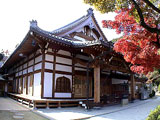
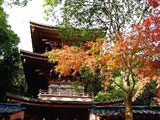
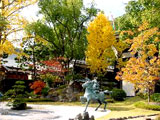
To access Sumadera Temple, walk north about 6-7 minutes from the Sumadera Station of the Sanyo Railway. The temple was built in 886 as part of the Shingon Sect. The temple is officially called Fukushoji Temple but affectionately known locally as "the Saint Kobo Temple of Suma." The temple has many items of historic significance and is an important cultural asset spanning from the Muromachi period and becoming a stage for the Genji-Heike battle in the 12th century. There are 25 stone tablets inscribed with haiku poems such as those written by Shiki Masaoka and Yosa no Buson, monuments inscribed with tanka poems, and literary stone inscriptions lined up within the temple. Maple, ginkgo, and cherry leaves turn beautiful shades of colors in autumn's interlude, lending a heightened sense of autumn elegance within the temple that overflows with the emotion of the rich history amidst its hallow grounds.
There are also many mysterious things to see in Sumadera Temple. Visitors may find themselves laughing despite themselves at the whirling Seven Gods of Good Luck riding the back of the turtle; the five monkey statues with moving hands placed to show not to see, not to speak, not to hear, not to get angry, and to pose; the frog with turning neck and eyeballs; the marionette clock, and the Bear cub Misha that makes a sound on the koto when its head is touched.
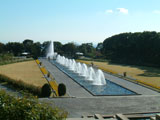
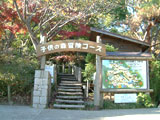
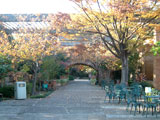
To access the Suma Rikyu Park, walk about 10 minutes from either Tsukimiyama Station or the Sumadera Station of the Sanyo Railway. It is a park spanning the remains of Muko Rikyu, a detached palace, and offering a bird's eye view of sea of Suma. Towards the end of 1914, a building made of Japanese cypress was built and named the Muko Rikyu but burned down from World War II. The pine forest and arrangement of garden rocks within the park and the row of pine trees from the main entrance continuing to the Suma seaside are the only traces of that time. It has been opened to the public as Suma Rikyu Park since 1967. The garden is remarkable for its wide spacious park with a grassy field, a centrally located rose garden styled after European gardens, and a big water fountain shooting water against the background of the ocean at Suma. In addition to a kid's plaza and athletic field, there are about 300 types of plum trees and hydrangea that can be seen with 80,000 pots of grass and flower planted in the botanical garden.
The autumn leaves of the park in the detached palace extend along the maple tree path from the Midori-taki Waterfall to the Japanese garden and the line of people enjoying the stroll is endless. Autumn leaves hanging from maple trees reflect in the surface of the water and fall into the flowing water in breath-taking scenery of vivid colors welcoming the autumn season. In November, centered on the botanical garden, there are 720 trees such as mountain maple, cherry blossom, Taiwanese sweetgum, dawn redwood, and wax forming an arch of red and yellow colored autumn leaves that are lit up at night at the end of November.
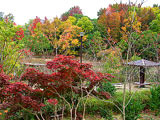
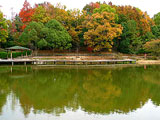
To access Okusuma Park, take city bus # 71 or #72 from JR/Sanyo Railway Suma Station and get off at "Okusuma Park."
The natural shapes enclosing the seven ponds are utilized intact at the park and are integrated with the grounds of Tainohata Yakuyoke Hachiman Shrine. Deep-bodied crucian carp have been released into the Komatsu-ike Pond for fishing. There is a tranquil residential section and in this quiet, relaxed atmosphere there is a vast green tract of land, ponds, and small river that have been preserved in their natural environment. Here 54 varieties of insects such as dragonflies and fireflies as well as wild birds such as kingfishers and Japanese pygmy woodpeckers can be observed. Moreover, the colorful leaves from such trees as Taiwanese sweetgum, Chinese tallow, Katsura tree, and swamp cypress give delight to the eyes of the Kobe citizens in autumn.

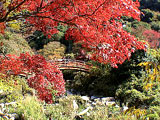
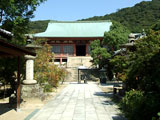
To access Taisanji Temple, take Shinki Bus #14 from the Igawadani Station of the Kobe Subway and get off at the Taisanji bus stop. Chief priest Joe, the eldest son of Fujiwara Kamatari, founded the temple as part of Tendai Buddhist Sect in 716. In the Kamakura period, it was a large Buddhist temple with 41 abbeys in the Igawa valley but now there are only 5 remaining. In this temple there is a beautiful Japanese garden that was built from the periods spanning the Momoyama and Edo periods. The main hall representative of the Kamakura period has been designated one of Kobe's national treasures for its architecture and the Deva gate and three-story pagoda are important cultural assets in Japan.
The mountains in vicinity of Taisanji Temple are called the Taisanji Virgin Forest. It is said that the virgin forest with its thickly growing trees such Japanese chinquapin and Quercus phillyraeoides has been left untouched from the Jomon period or the stone age and subsequently has been selected as a prefectural natural monument and one of "Top 100 Scenic Places in Hyogo Prefecture." There are about 160 different varieties of plants growing naturally to form a broad-leaved and evergreen forest acting as an important habitat for multitudes of birds and small animals. In autumn, the colorful leaves of Taisanji temple including those of maple trees are particularly beautiful in reflecting the charming colors of autumn against the crimson red background of the more than 700-year-old main hall and three-story pagoda. Crowds of visitors visit the temple as a famous place in the Kobe City that is preeminent in the beauty of the autumn leaves.
Also, near the temple is a natural radium spa called "Taisanji Nadeshiko Bath," and it is especially enjoyable to enjoy a mineral bath when taking an excursion for viewing the autumn leaves. Also, the Japanese garden of An'yo-in Temple located within the Taisanji's grounds is designated as a national garden of exceptional beauty, the only one in the Kobe City that is opened to the public in mid-November for viewing the beautiful autumn leaves.
